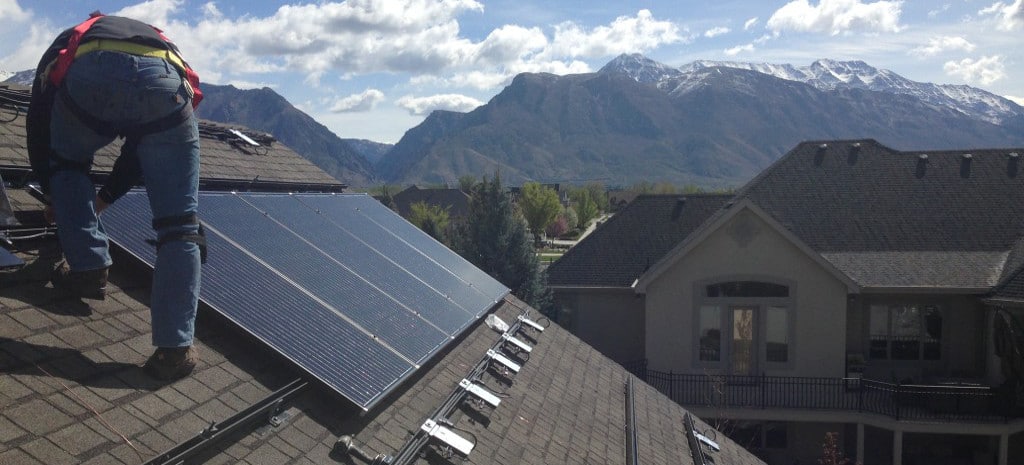by Alan Naumann*
 The new solar agreement between Utah Gov. Gary Herbert and Rocky Mountain Power is all RMP. Despite other “stakeholders” at the table, RMP, owned by Warren Buffet, received everything it wanted. Just by threatening higher costs on solar customers, RMP has succeeded in curbing the growth of solar in our state and gained new advantage over the industry with new rules of the game.
The new solar agreement between Utah Gov. Gary Herbert and Rocky Mountain Power is all RMP. Despite other “stakeholders” at the table, RMP, owned by Warren Buffet, received everything it wanted. Just by threatening higher costs on solar customers, RMP has succeeded in curbing the growth of solar in our state and gained new advantage over the industry with new rules of the game.
The solar industry is growing 15 times faster than the national average. But not in Utah, RMP’s idle threats of higher solar rates has stunted the growth of Utah’s solar industry to 12% in the first six months of 2017.
Utah’s solar industry could have doubled this year. Lost to Utah are thousands of jobs and hundreds of millions of dollars that could have flowed into Utah. New money to the state comes in two ways from every solar job. You get to keep your tax dollars right at home financing a family asset. And thousands of dollars in state and federal taxes can be used to purchase an income generating solar system. The dollars to finance a solar project are from a third party lender, usually out-of-state. These loans are out-of-state money invested in Utah. We all win.
This shortsighted settlement forces our entire solar industry, including 4,400 Utah jobs, into a two-month deadline, on November 15. Never in history has an industry had to respond so quickly to such tumult. The goal was to depress our growing clean energy industry and make new rules in the utilities’ favor.
The solar industry now has a limit on how many years we are allowed to be connected to the grid at a fixed price (18 years, if before November 15, only 15 years after November 15).This agreement does not settle the long-term issue of setting the value of solar energy.
Now we will have a three-year transition period to study what we already know, that solar is worth at least 14 cents/kilowatt-hour (kWh). We know solar has a value of at least 14 cents/kWh, because that’s what RMP charges for clean energy in its Subscriber Solar and Blue Sky programs.
Negotiators to this agreement were under a gag order throughout the talks, and still remain silent to the press. The Utah Solar Energy Association (utsolar.org), representing 26 of Utah’s 90 solar companies, signed on to this agreement. Our states’ largest solar companies, such as Vivint Solar, sPower, Hunt Electric and Intermountain Wind and Solar, all do most of their work out of state.
Utah Clean Energy and Heal Utah are also signers to this agreement. The Sierra Club, which put upwards of $150,000 into this fight with Rocky Mountain Power over two years, will remain neutral, so not to upset the locals’ efforts.
This solar agreement was just announced August 28. The Utah Public Service Commission decided to accept this settlement as law on September 30. The agreement calls for a little known cap on total solar installed at 170MW for residences and schedule 23 (small solar farms). And only 70 MW of commercial solar could be installed during the three-year transition period. This docket was supposed to be residential only. How can you make new rules on commercial projects without prior discussion?
We should be encouraging people to invest in solar. Solar buyers are building part of our new clean and smart grid with their own money. They are the heroes, not Rocky Mountain Power. RMP is still at least 60 percent coal powered. There is still no severance tax on coal in Utah, unique among all our neighboring states of both political parties.
This op-ed was first published in the Salt Lake Tribune, and has been reprinted with the permission of the author.
*Alan Naumann is a sales manager for Rocky Mountain Renewable Energy. This op-ed reflects his own opinions, and not necessarily those of his company.
The views and opinions expressed in this article are the author’s own, and do not necessarily reflect those held by pv magazine.
This content is protected by copyright and may not be reused. If you want to cooperate with us and would like to reuse some of our content, please contact: editors@pv-magazine.com.








By submitting this form you agree to pv magazine using your data for the purposes of publishing your comment.
Your personal data will only be disclosed or otherwise transmitted to third parties for the purposes of spam filtering or if this is necessary for technical maintenance of the website. Any other transfer to third parties will not take place unless this is justified on the basis of applicable data protection regulations or if pv magazine is legally obliged to do so.
You may revoke this consent at any time with effect for the future, in which case your personal data will be deleted immediately. Otherwise, your data will be deleted if pv magazine has processed your request or the purpose of data storage is fulfilled.
Further information on data privacy can be found in our Data Protection Policy.